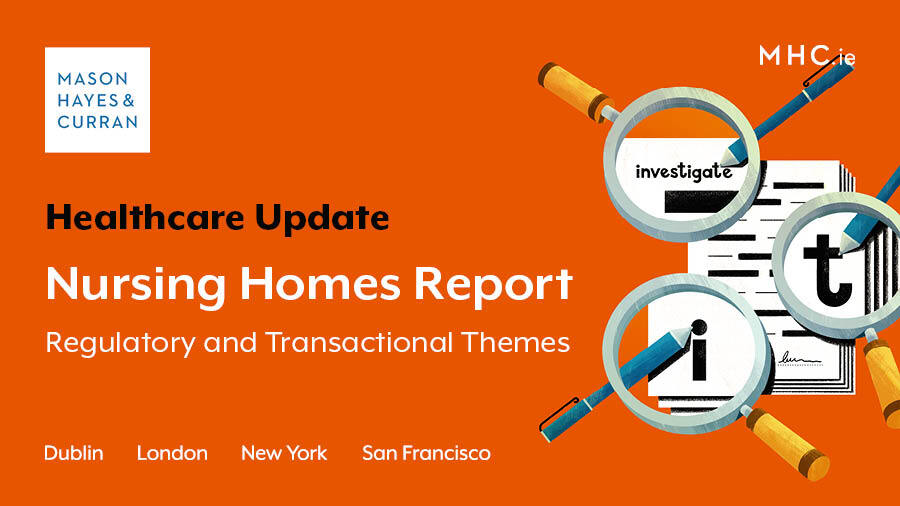
PwC have recently published an independent report on nursing homes in Ireland, “Challenges for Nursing Homes in the Provision of Older Persons Care - Private and Voluntary Nursing Home Sector” (the Report). The Report highlights in detail the current challenges facing the sector in Ireland. We discuss some of the regulatory and transactional
key considerations arising from the Report.
Regulatory
The dominant theme in the Report is that costs for private nursing homes in Ireland have dramatically increased, due to a whole range of factors, including the following:
- Energy costs
- Increased staff costs
- Higher dependency resident profile
- Food inflation
- Rising operational costs driven by infection prevention control requirements, and
- Increased regulatory burden requiring renovations caused by the HIQA regulations and in particular S.I. No. 293 - The Report points out that capital expenditure is likely to continue increasing over time in line with heavier HIQA requirements
The Report argues, as does widespread commentary in the sector, that the amounts paid to nursing homes under the National Treatment Purchase Fund (NTPF) pricing mechanism for determination of Weekly Fair Deal Rates, need to increase in line with those increased costs. This scheme operates within the context of a fixed annual budget as set in the Government’s annual estimates process. It seems very clear that this budget now must be substantially increased.
One immediate action called for in the Report is for funding to be made available to the NTPF to enable it to prevent further nursing home closures, even before the Fair Deal Rate pricing mechanism is reformed.
The NTPF carries out negotiations with each nursing home as opposed to collective organisations. Agreed Weekly Fair Deal Rates per resident are fixed for the term of agreement, typically 24 months. The Report notes that the rate setting mechanism can result in inconsistencies, with identified cases of similar nursing homes in terms of size, location etc obtaining differing Fair Deal Rates. The Report argues that the methodology fails to fully capture factors such as dependency mix and operating costs. In addition, the Report highlights that NTPF nursing home financial reviews are primarily based on historic data, meaning due consideration is not given to the prospective financial year. The Report argues that these mechanisms now require reform.
Transactional
Another overarching theme of the Report, is the need for more nursing home beds in Ireland, and the extent to which this need will become more pronounced in the coming years. However, the Report sets out a decreased attractiveness for investors in investing in the sector in Ireland, due to escalated costs and collapsed margins. Some useful statistics on this included in the Report are:
- There has been a 36% increase in operational cost of care per resident since 2017.
- There has been a 47% increase in development costs per bed since 2017.
- Capital expenditure per bed has increased by 82% over the past 5 years.
- Many nursing homes have fixed agreements with the “PropCos” relating to yields and interest rates that have led to rents increasing over the past 4 years. This, coupled with CPI-related increases and overall Irish property market trends, has led to rents per bed increasing by 23% between 2019 and 2022.
Rising interest rates for finance, construction costs and land prices therefore all make for an increasingly unattractive equation for investors and operators, not just in new builds but in extensions and upgrades.
The Report calls for a system that can incentivise the development of additional nursing home capacity, and provide both a viable return on investment and ensure value for money for the State.
The Report expresses the view that new developments in the sector are unlikely to commence over the coming years due to insufficient returns for providers to reward the risk of investment. A concerning observation of the Report is that the development landscape will actually get worse before it gets better. The Report states that nursing home bed capacity coming on stream over the next two years is the result of locked-in development costs from investments that occurred pre-2022. It explains that the long lead-in times involved in new nursing home developments mean that the current non-viable business case will have a limited effect on the number of beds being added to the market in 2023 but will cause a significant drop in sector expansion from 2024 onwards.
Conclusion
It is clear that the nursing home sector faces significant challenges, and the Report draws out the factors which indicate that the situation is likely to get a lot worse unless there is policy change. Aside from a re-calibration of Fair Deal, incentives for extension and new developments of homes would also be very helpful in seeking to increase the viability of increasing the number of nursing home beds in Ireland. Increased regulation for homes is welcome in some respects, but the cost of compliance has also driven up the cost of care, and this needs to be borne in mind as the regulatory burden continues to increase on providers.
For more information, contact Robert Dickson or any member of our Corporate or Healthcare teams.
The content of this article is provided for information purposes only and does not constitute legal or other advice.






